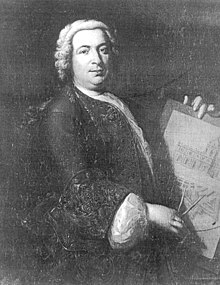Leopoldo Retti
Leopoldo Mattia Retti , also known as Leopold Retty (* 1704 in Laino , Lombardy ; † September 18, 1751 in Stuttgart ) was an Italian architect who worked in southern Germany . He is considered one of the leading representatives of the French late baroque.
Life
Leopoldo Retti came from a family of artists, his father Lorenzo Mattia Retti was a plasterer , the plasterer Donato Riccardo Retti , the painter Livio Retti and the architect Paolo Retti were his brothers. His uncle, the plasterer and master builder Donato Giuseppe Frisoni , who in 1714 was commissioned to continue building the palace at Ludwigsburg Palace , had Leopoldo and his brothers from Laino come to Ludwigsburg in 1717 . While the three older brothers worked as plasterers and painters, Leopoldo received basic architectural training based on the model of Robert de Cotte in Paris .
In 1726, the Duke of Württemberg transferred the entire construction activity of the new city of Ludwigsburg to Leopoldo Retti, who was immediately in the rank of lieutenant and received an annual fee of 400 guilders. In 1731 Retti received the call to Ansbach , where he was appointed captain and became a model for many Italian artists, such as the brothers Diego and Carlo Carlone . When Leopoldo's predecessor Carl Friedrich von Zocha resigned, he became the margravial chief building director in 1732 . 1741, he received the rank of artillery - majors .
After a short break due to the war, Retti received the general planning for the New Palace in Stuttgart from Duke Carl Eugen von Württemberg in 1745 . In 1748 and 1749 Retti made plans for Karlsruhe Palace . However, his plans did not materialize. One of his students was Albrecht Friedrich von Kesslau , who later became a margrave architect in Karlsruhe
Leopoldo Retti died on September 18, 1751 of an unknown illness in Stuttgart and was buried in the Catholic cemetery in Oeffingen . The architect Maurizio Pedetti was his sister's son.
The Ansbach-based Förderverein Retti eV has set itself the goal of honoring his lifetime achievement.
Honors
A street was named after him in Ansbach and Nuremberg-Mögeldorf.
Buildings (selection)
- Ansbach residence , work to be continued
- City Palace (so-called Retti-Palais ) Ansbach
- Synagogue Ansbach
- Dennenlohe Castle
- Eschenau Castle , renovation
- Freudental Castle , attributed to Paolo Retti
- Evangelical Church of Peter and Paul, Gerabronn
- Kirchberg Castle , renovation
- Ludwigsburg residential palace
- Schwaningen Castle , renovations
- Evangelical St. Bartholomew Church in Sommerhausen
- Former rectory in Sondernohe , Flachslanden market
- New Stuttgart Castle
literature
- Klaus Raschzok: Retty, Leopold. In: New German Biography (NDB). Volume 21, Duncker & Humblot, Berlin 2003, ISBN 3-428-11202-4 , p. 449 f. ( Digitized version ).
- Rolf Bidlingmaier: The Protestant parish church of St. Bartholomew in Sommerhausen. A church by Leopoldo Retti . In: Mainfränkisches Jahrbuch , Jg. 47 (1995), pp. 119–148; with explanations going beyond the planning of St. Bartholomäus on the importance of Rettis as a church builder in Franconia.
- Christian Schoen / Förderverein Retti eV (ed.): The court architect Leopoldo Retti and his Ansbach city palace , Ansbach 2016 ISBN 978-3-9818-0070-8
Web links
- Memorial exhibition on the 250th anniversary of Leopoldo Retty's death
- from Graevenitz Castle Freudental
- Stuttgart commemorates Retti
- Exhibition in the Retti-Palais
- Förderverein Retti eV
Individual evidence
- ^ Hans A. Klaiber: Donato Giuseppe Frisoni. In: New German Biography (NDB). Volume 5, Duncker & Humblot, Berlin 1961, ISBN 3-428-00186-9 , p. 621 ( digitized version ).
- ^ Leopold Retty on deutsche-biographie.de (accessed on January 4, 2017).
- ↑ Leopoldo Retti in franken-wiki.de (accessed on: April 17, 2016.)
- ^ Leopoldo Retti (Italian) in assomarmistilombardia.it (accessed on: April 11, 2016.)
- ↑ Leopoldo Retti. In: Mariusz Karpowicz: Artisti ticinesi in Polonia .. 1999, pp. 167, 168.
- ↑ Leopoldo Retti on sueddeutscher-barock.ch (accessed on January 3, 2017).
- ↑ Ursula Stevens: Leopoldo Retti. In: tessinerkuenstler-ineuropa.ch. 2016, accessed November 21, 2016 .
- ^ Michael Bringmann: Mauritio Pedetti. In: New German Biography (NDB). Volume 20, Duncker & Humblot, Berlin 2001, ISBN 3-428-00201-6 , p. 157 ( digitized version ).
| personal data | |
|---|---|
| SURNAME | Retti, Leopoldo |
| ALTERNATIVE NAMES | Retti, Leopoldo Mattia (full name); Retty, Leopold |
| BRIEF DESCRIPTION | Italian architect |
| DATE OF BIRTH | 1704 |
| PLACE OF BIRTH | Laino , Lombardy |
| DATE OF DEATH | September 18, 1751 |
| Place of death | Stuttgart |
